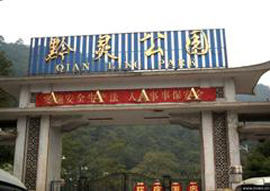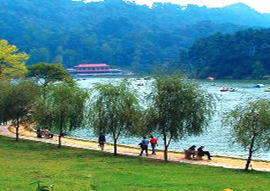Situated on Qianling Hill, which is 1.5 kilometers from the center of Guiyang City, the park covers an  area of 426 hectares. First built in 1957, it is a unique park in the city and a 4-A National Tourist Attraction. It takes the name from the Qianling Mountain in the park, which is the most famous mountain in southern Guizhou. As one of the noted gardens on the Guizhou plateau, it boasts clear waters, green mountains, tranquil forests and old temples. More than 500 energetic and enchanting macaques live in the mountain in the park. There are eight predominant scenic locations: Sanlingwan, Macaque Garden, Hongfu Temple, Kylin Cave, the Zoo, Qianling Lake, the Wind-Rain Bridge, and the Winding Mountain Path. area of 426 hectares. First built in 1957, it is a unique park in the city and a 4-A National Tourist Attraction. It takes the name from the Qianling Mountain in the park, which is the most famous mountain in southern Guizhou. As one of the noted gardens on the Guizhou plateau, it boasts clear waters, green mountains, tranquil forests and old temples. More than 500 energetic and enchanting macaques live in the mountain in the park. There are eight predominant scenic locations: Sanlingwan, Macaque Garden, Hongfu Temple, Kylin Cave, the Zoo, Qianling Lake, the Wind-Rain Bridge, and the Winding Mountain Path.
Hongfu Temple
Originally built in 1667, it is the largest temple of Zen Buddhism in Guizhou Province. It features majesty and sobriety. Hongfu means to develop Buddha's spirits and to benefit mankind. Today it is rated as one of the 142 national key temple scenic areas as well as the key cultural relic preservation in Guizhou Province.
On entering the gate of the temple, you will see the Bell Tower and the Drum Tower on both sides. The bronze bell weighs more than 3,000 Jin in Chinese measurement (equal to about 3,300 pounds), and was cast in 1469 during the Ming Dynasty (1368-1644).
In the first hall named Heavenly King Hall, you can see the statues of Maitreya Buddha and the four Heavenly Kings. On the walls there are also steles of sutra and colorful paintings. The second main hall is the Bodhisattva Hall dedicated to Bodhisattva Avalokiteshvara with 32 arms. In the third hall named Mahavira Hall there are gilded statues of Sakyamuni and the 18 Arhats. There's also a jade Buddha statue from Rangoon, the capital of Burma. It is 1.5 meters high and weighs 900 kilograms. The statue looks beneficent but solemn, and it stands among more than 10 other jade statues of Bodhisattva and Maitreya.
Besides these superb halls, the temple is also adorned with galleries, pools, and springs, which are of high artistic value.
Qianling Lake
Qianling Lake was made by the damming of the Daluo Spring in 1954. In 1999 when the project of clearing up the silt in the lake was completed, it has an area of 35 hectares with clearer water and a steady dam. The crystalline surface mirrors the green and gentle willows and the surrounding pavilions that are ornately decorated and finely built. On its western bank stands a memorial for the martyrs who died during the war of liberation of Guizhou Province. Every Tomb-Sweeping Day, thousands of people go there to worship the heroes.
Macaque Garden
Qianling Park, with 98% of forest cover, is the perfect habitat for macaques. More than 500 of them live in the Macaque Garden. Energetic and enchanting, they jump and frolic here and there, attracting a lot of visitors. Out of the big cities in China, it is only Guiyang that has such a large garden for monkeys.
Kylin Cave
Down along the 382-step Nine-Twist Path, the short cut, there is Kylin Cave. In front of the cave flows a 400-year-old spring. Among stalactites of various shapes hanging inside, there is a huge one weighed down like a kylin (a beast symbolizing auspice in China), giving the cave its present name.
The cave is noted for its reputation that Chiang Kai-Shek, the leader of Chinese Nationalist Party at that time, captured the patriotic generals Zhang Xueliang and Yang Hucheng at the cave during the War of Resistance against Japan. Many Chinese people come to visit the cave because of its story. |
